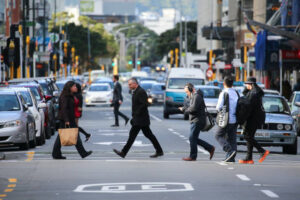Cobham Drive and other LGWM plans
I have written for some time now about the failure, inadequacy and political bias of Let’s Get Wellington Moving (LGWM). Finally, Wellington businesses have banded together to say they have also had enough of this nonsense.
Eighteen companies from the Progress Wellington group placed a full-page advertisement in the Dominion Post on 5 August 2021 about Let’s Get Wellington Moving, not stopping. This is exactly what LGWM has been attempting to do over the past year. They have made no attempt to resolve congestion problems and have set out to do the opposite. The catalyst for this push back was the absurd and disruptive Cobham Drive pedestrian crossing proposal. Even the mayor is opposed to this idea, but will his council back him? Probably not.
To date, the most significant move by LGWM has been to push forward with the radical option to remove all cars from the Golden Mile and the side streets, despite many concerns from businesses. I have written on this before (A Carless Golden Mile and the side streets – A Radical Move), and I quoted Siobhan Procter (Programme Director for LGWM) who stated the removal of cars would have very little impact on retail. Hello!! you have just removed 22% of a retailer’s income, that is a massive hit to the profitability of all those businesses.
Further, I wrote in the same article about the congestion this move will make. I mentioned the problems this would cause at the Cambridge Terrace, Tory Street and Taranaki Street intersections, but failed to mention the issues driving from Brooklyn. Closing Willis Street will force Brooklyn traffic either onto the Terrace or into the city via Guzhnee Street and Taranaki Street to cross town, for example. This will create more congestion. Has LGWM done analysis on this and other problems that will occur by closing the Golden Mile? Probably not.
Another area that will be impacted by LGWM’s misguided moves is Thorndon Quay and Hutt Road. So far, I have taken little notice of this, as I rarely go along these roads. However, retail here will also be greatly affected. Retail NZ chief executive Greg Halford said “the Cobham Drive proposal, the decision to ban cars from the Golden Mile and a redesign of Thorndon Quay on Hutt Rd would have ‘significant adverse impacts’ on Wellingtonians. What do all these projects have in common? A lack of data, economic analysis, and little understanding of how it will impact on the city, its people, and the business community,” (Dominion Post, 5 August 2021).
While Progress Wellington have been formulating their plans over the past several weeks, the Cobham Drive pedestrian crossing, rather than a bridge or underpass was clearly the last straw for businesses. LGWM was simply not listening. “If Let’s Get Wellington Moving goes ahead with their plan to reduce the speed limit on Cobham Drive and add a set of traffic lights, more than 35,000 motorists (per day) will be impacted while the best and safest solution for pedestrians and cyclists will be ignored” (Dominion Post, 5 August 2021).
The Long Tunnel proposal
Earlier this year I heard rumours that LGWM had received a proposal on a long tunnel for Wellington via a news item that stated it had also been heavily redacted. I wrote at the time; I have hinted at a tunnel being built under Wellington in my blog “The Cost to Re-Build Central Wellington Without Cars”. This would solve the many problems outlined above and remove much of the traffic in central Wellington and open the congestion to the Eastern suburbs and airport. Further, where this has been done in Auckland, Sydney, Melbourne and Brisbane, removal of traffic from the city centre has been beneficial by reducing congestion and travel times. Productivity has also improved with economic benefits. So why the secrecy on this, when there are so many positive outcomes?
The report was commissioned by LGWM but was held back, and only released now. The Property Group who wrote the report said a long tunnel “would open up the most new space for housing and urban development” (Dominion Post, 3 August 2021), as well as reducing congestion in the city centre. I have also argued that the Terrace Tunnel be doubled and linked to the long tunnel.
Sadly, Greater Wellington Regional Council Chairman Darren Ponter said the report was “contextual as much as anything else”, and he did not expect many of the ideas “to become reality” (Dominion Post, 3 August 2021). Ponter added a long tunnel was a “particularly radical solution” and would be “phenomenally expensive” (Dominion Post, 3 August 2021).
Interestingly, one of the benefits of this proposal is the potential to create 44,000 jobs and 38,600 new homes. Whilst building a long tunnel might be expensive, it will have some major economic and housing supply benefits. To support this argument, I quote Dr Eric Crampton, chief economist with The NZ Institute (I also referred to this in my article – The Cost to Re-Build Central Wellington Without Cars):
“So how do we get spending on infrastructure we need while avoiding wasting money on white elephants, when the main political parties seem to really just like spending money on their own preferred modes of transport?
“The best solution maybe to take these decisions out of the hands of politicians.
“Imagine if the proposed bicycle bridge, or the proposed tunnel, were forced to go to external investors to find financing, rather than beg politicians for it. The Auckland Harbour Bridge Board issued bonds in the 1950s; those bonds funded the bridge. Tolls paid by drivers paid off the bonds. It is an important and forgotten part of New Zealand’s transport heritage.
“If infrastructure were funded this way, business cases would need to convince investors with real money on the line. Would either the bridge or the tunnel really see enough paying customers to make the venture worthwhile? That would depend not only on the attractiveness of the transport option, but also on the new housing opportunities it might unlock.” (Dominion Post, 9 August 2021).
The consequence of not considering this option, or alternative funding options, is that the government’s desired housing supply does not get built, and the inevitable congestion problems will not be resolved.

